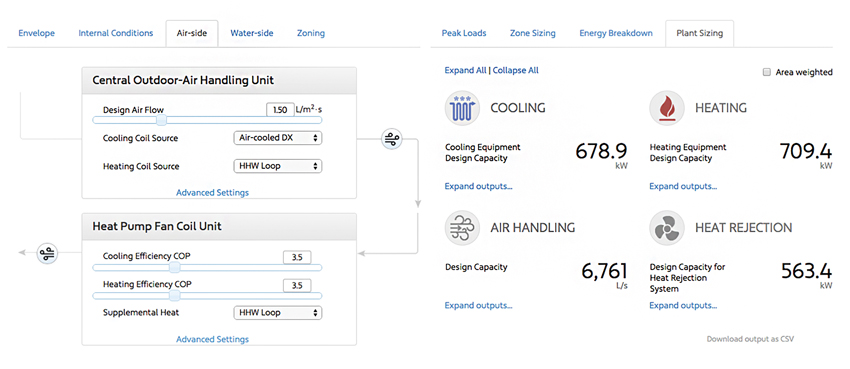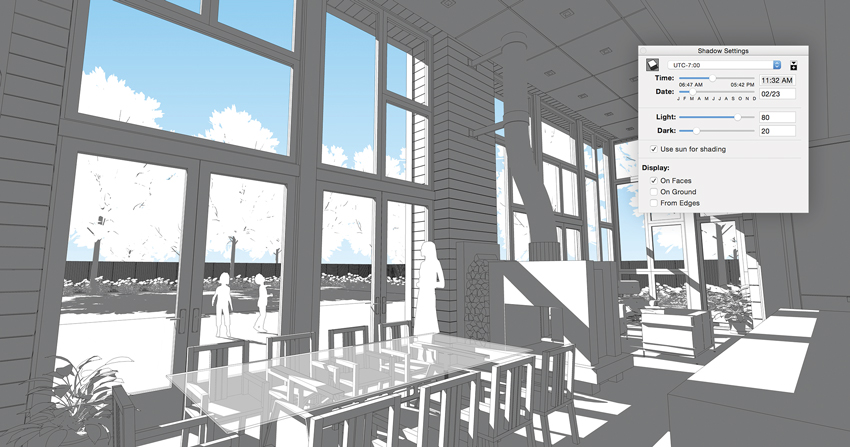The Benefits of a Performance-Based Design Process
Understanding the Importance of Performance-Based Design
The energy performance of a building is impacted significantly by internal systems, like HVAC systems and lighting systems, and by the building envelope. While the environmental and financial benefits of a PBD approach are discussed later in the course, it is important to understand how and why design decisions can impact certain systems. When it comes to designing high-performance buildings, energy use is one of the most important considerations, and the decisions surrounding it can impact occupant comfort as well as operational costs. For example, when a PBD approach is used for a project, architects and designers can quickly and iteratively explore the energy and comfort impacts of different glazing and shading strategies for a building’s windows, and this can directly impact HVAC and electrical system needs. By comparing the tradeoffs between desired daylighting levels, energy use, and comfort needs, architects can make sure they include properly sized mechanical systems, appropriate window materials and glazing, and alternative electrical systems if needed. For example, the capital cost of installing photovoltaic cells may be offset by the lifetime operating costs of electricity. PBD can help designers understand this tradeoff at the start of the project.
Because of the complexity of modern design, the various aspects of building performance, comfort, health, and safety are interrelated and can’t be considered in isolation.
Windows are a prime example of this. Adjusting the size, glazing, and thermal performance of the window affects more than just the quantity of light entering the building. Window performance has a cascading impact on the comfort of the occupants and the overall energy use of the building. Window performance determines how much solar gain gets into the space, which affects the cooling load. Windows also impact heat loss by conduction through the glass, which affects the heating load. In turn, expected heating and cooling loads should determine the size and type of the HVAC system, which then impacts capital costs and operational energy costs. The traditional design approach often has HVAC and envelope decisions, like windows, made independently rather than considering their impacts together. With a PBD approach, if an architect reduces glazing area or adds shading to a project, the PBD tool would incorporate this potential reduction in cooling load and, in response, reduce the size of the system or suggest a different system type altogether.
To better understand the impact of PBD, let’s examine some of the potential benefits to this new design philosophy when attempting to create more sustainable, comfortable, and safe buildings.
Construction Resource and Energy Use
Green building has become mainstream, to such an extent that every phase of construction—from resource extraction, processing, and transportation to physically constructing the building—must now be taken into account when evaluating a project’s sustainability. And the ability to understand and evaluate all of these interrelated inputs early in the design phase—by using a PBD process—can help optimize the performance of the design.
Post-Construction Energy Costs
Post-construction energy costs are just as important, if not more so, than the energy costs incurred during construction. The operational costs associated with machinery and HVAC equipment, electrical systems, as well as ongoing maintenance costs all contribute to the lifetime cost of the building.
Projects that use a PBD approach in their design process can better estimate the ongoing energy needs of the building before it is even created. Operational costs are a direct result of design decisions and will impact the energy use and maintenance costs of the building over the course of its entire functional lifetime. The PBD approach helps designers minimize these costs by setting performance goals and metrics, and determining the best way to meet those goals through the decisions they make early in design.
Proper Sizing of HVAC Equipment
Architects and builders need to understand how to size their HVAC systems to match the actual needs of a project in order to maximize the project’s efficiency, and they need to make sure that the system is properly installed in order to maintain energy efficiency, particularly in a high-performance building.

Image courtesy of Sefaira
Properly sizing the HVAC system is critical not only for both occupant comfort and energy costs, but also for capital costs.
When it comes to HVAC systems, more often than not, architects rely on engineers to properly size equipment. Engineers, wanting to avoid costly mistakes, build redundancy into their systems, which often means “bigger is better.” But with high-performance, energy-efficient buildings, “bigger” may simply mean more costly and energy intensive, and may result in over-heated and over-cooled buildings, which ultimately negatively affect occupant comfort. A system that is much too small for the space will fail to meet occupants’ comfort needs. However, a slightly undersized HVAC system—roughly 10 percent or less—has been found to operate more efficiently than a perfectly sized system. Moreover, a system that has been designed for continuous operation can provide more uniform heating and cooling, as well as help maintain proper air humidity levels.
A properly sized HVAC system paired with a carefully designed and operated building can reduce the capital costs of a project when compared to an oversized system, and can improve occupant comfort, all while reducing utility costs and improving overall operating efficiency. The PBD process considers heating and cooling loads early enough that they can still be meaningfully changed by adjusting the design, whereas the traditional design process takes heating and cooling loads as a given, then designs an often oversized HVAC system to meet those needs. The PBD approach allows for a much more comprehensive evaluation that includes all the known parameters before committing to an HVAC system for the project.
Daylighting
As noted earlier, daylighting (i.e., using natural light to illuminate a building’s interior) is one of the more important elements to consider when designing for occupant comfort. The challenge, however, is that too much natural light can be too bright for occupants, and it can increase cooling loads and energy use. A beautiful view that brings in sunlight for a good part of the day may be great for the occupant experience, but not if it means that the space is too bright or too warm, especially in already warm environments. Moreover, the stress that too much daylight can have on the HVAC system (i.e., cooling) can affect both the capital and operational costs of the building, as the system may need to be replaced sooner and may be required to run more often.
As a way of avoiding some of these problems, a building designed with the PBD approach can introduce, analyze, and ultimately balance the many interrelated factors that can affect daylighting performance. From the very start of the project, architects and designers can consider window glazing ratios, glazing locations, and glazing materials, as well as how different shading strategies may impact building design, occupant comfort, energy use, and HVAC size.
Implementing a PBD approach on a project can help architects and designers better understand the impact of daylight and direct sunlight. They can thus improve their designs and find the balance between aesthetics, occupant comfort, and overall performance. Some of the common design questions that architects can deal with more effectively using a PBD process include: detailed shading design, passive solar design, exterior solar access, sunlight prevention to light-sensitive spaces, and how to meet certification requirements.










